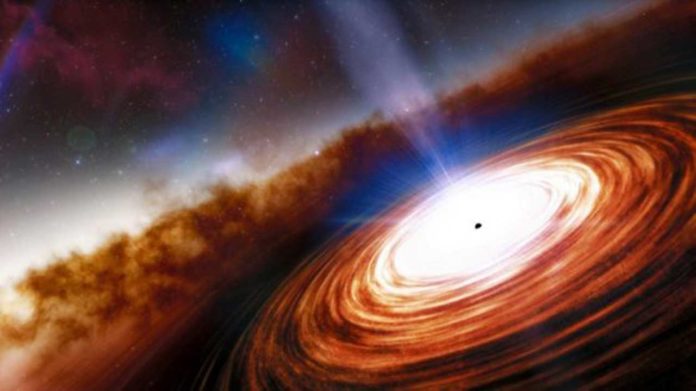A team of astronomers has recently discovered the most distant quasar ever. Located about 13.03 billion light-years from Earth, the quasar sheds light on how black holes grow.
Despite being most distant, the quasar is the earliest and first of its kind to show evidence of an outflowing wind of superheated gas escaping from the black hole‘s surroundings at a fifth of the speed of light. In addition to revealing outflowing wind, new observations also show intense star formation in the host galaxy where the quasar, formally designated J0313-1806, is located.
Although J0313-1806 is only 20 million light-years farther away than the previous record holder, the new quasar contains a supermassive black hole twice as heavy. This marks a significant advancement for cosmology, as it provides the strongest constraint yet on the formation of black holes in the early universe.
Lead author Feige Wang, a Hubble Fellow at the University of Arizona’s Steward Observatory, said, “This is the earliest evidence of how a supermassive black hole is affecting its host galaxy around it. From observations of less distant galaxies, we know that this has to happen, but we have never seen it happening so early in the universe.”
The newly discovered quasar provides a new benchmark by ruling out two current models of how supermassive black holes form in such short timescales. In the first model, massive stars that consist largely of hydrogen and lack most other elements that makeup later stars, including metals, form the first generation of stars in a young galaxy and provide the food for the developing black hole. The second model involves dense star clusters, which collapse into a massive black hole right from the outset.
Quasar J0313-1806, however, boasts a black hole too massive to be explained by the aforementioned scenarios, according to the team that discovered it. The team calculated that if the black hole at its center formed as early as 100 million years after the Big Bang and grew as fast as possible, it still would have had to have at least 10,000 solar masses, to begin with.
Co-author Xiaohui Fan, Regents Professor and associate head of the UArizona Department of Astronomy, said, “This tells you that no matter what you do, the seed of this black hole must have formed by a different mechanism. In this case, one that involves vast quantities of primordial, cold hydrogen gas directly collapsing into a seed black hole.”
“Because this mechanism doesn’t require full-fledged stars as raw material, it is the only one that would allow the supermassive black hole of quasar J0313-1806 to grow to 1.6 billion solar masses at such an early time in the universe. This is what makes the new record quasar so valuable.”
“Once you go to lower redshifts, all the models could explain the existence of those less distant and less massive quasars. For the black hole to have grown to the size we see with J0313-1806, it would have to have started with a seed black hole of at least 10,000 solar masses, and that would only be possible in the direct collapse scenario.”
This newly discovered quasar offers a view into the life of a galaxy at the dawn of the universe when many of the galaxy-shaping processes that have since slowed or ceased in galaxies that have been around for much longer were still in full swing.
U-M astronomer Jiangtao Li said, “University of Michigan’s partnership in the world-class ground optical/infrared telescopes, such as the twin 6.5m Magellan telescopes, and the future 39m Extremely Large Telescope, will provide its researchers and students a lot of unique opportunities to study various interesting objects in the early ages of the universe. These studies will play a critical role in our understanding of the formation and evolution of supermassive black holes, galaxies, and large-scale structures over the cosmic time.”
The research team also includes astronomer Richard Green and doctoral student Minghao Yue, both at Steward Observatory. The research was funded by NASA, the National Science Foundation, the European Research Council, and the National Science Foundation of China.
